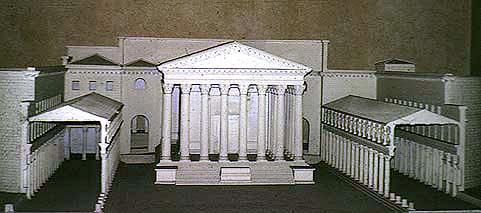
Salve. Forgive me for disturbing you, but you looked like you were lost. You are now standing in the grand Forum of Augustus, which is known in Latin either as the forum Augustum, the forum Augusti, or the forum Martis. You are now standing in the Southeast Colonnade of this magnificent precinct.
I'm sorry, I guess I should introduce myself. Mihi nomen est Ambulator (learn more about the MOO architect, Ambulator). I am a freedman of the imperial family; I was once owned by the great Augustus himself. I helped build this place, which is why I enjoy talking about it so much. In fact, Augustus freed me after he dedicated the forum in DCCLII AUC (752 years from the founding of the city (ab urbe condita), which for all you foreigners was 2 BCE.
You were supposed to enter from the Forum of Julius Caesar on the south side of the forum, but because of some repairs there, you had to enter here into this colonnade. You can see that this colonnade is three steps above the courtyard. The pavement here is made up of rectangular flagstones of beautifully colored marble. These columns are made of cippolino marble with some other colored marble used here as well. You can see how tall they are with me standing beside one. They are 9.5 meters tall. We used Corinthian columns in the colonnade and entablatures made of white marble. On the deep attic you will see on the facade caryatids alternating with carved shields. The caryatids are miniature replicas of the ones on the Erechtheum in Athens. The shields have faces of divinities like Jupiter Ammon carved onto them.
Here on the back wall are rectangular niches framed nicely by engaged columns that line up with the columns in the colonnade. These niches contain statues of important men throughout the history of Rome, personally selected by Augustus and his advisors. You can read about them as we walk past, since below each statue is a marble plaque inscribed with a summary of that man's illustrious deeds (note for example this elogium of Marius, who was married to Julius Caesar's aunt). Suetonius explains the reason Augustus included all these statues of illustrious men:
Professus et edicto: commentum id se, ut ad illorum vitam velut ad exemplar et ipse, dum viveret, et insequentium aetatium principes exigerentur a civibus. (Divus Augustus 31)
Augustus declared in an edict that he had devised this so that he himself, while he lived, and the leaders of subsequent periods might be measured against the life of these men as a standard.